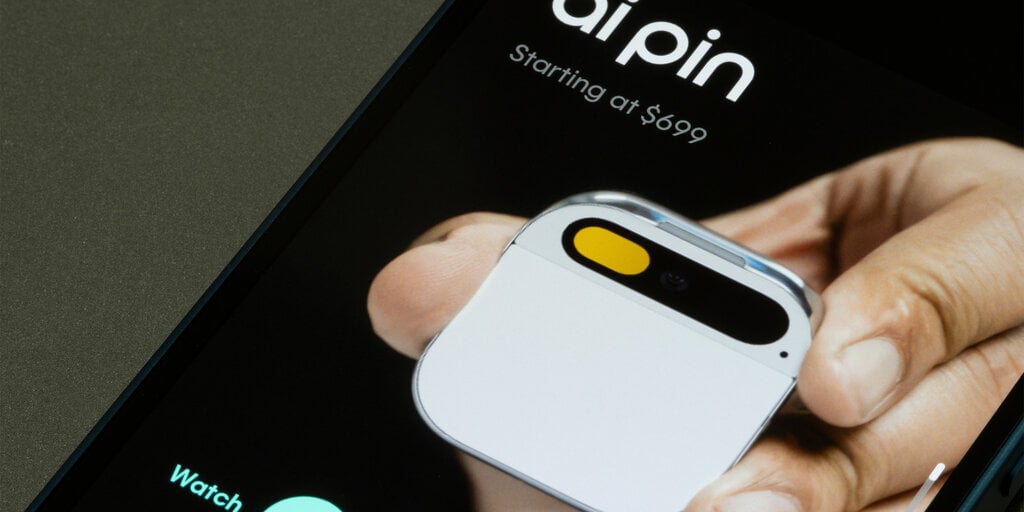It was in the comparable primordial days of AI hardware when the Humane AI pin was announced, a $700 wearable that was teased on a fashion runway and led a nascent category of device that soon included the $200 Pocket AI and the yet-to-be-released Rewind Pendant.
Months later, the review embargo finally expired, and dozens of tech media and influencers went live with their early-adopter thoughts. The overall verdict was grim.
“A promising mess” declared a Washington Post headline, while Wired said the Humane AI gadget was “too bare bones,” too clunky, too limited. Things only went downhill from there.
The Humane AI Pin was pitched as an AI-powered personal assistant, replete with an onboard large-language model (LLM) and a laser-powered, palm-pointing display. Attached to your shirt with a magnetized battery pack, the real heft came from its price tag of $699 upfront, plus a $24 monthly subscription fee.
The idealistic vision of wearable AI is a post-smartphone world, where you can access your own information and the world’s information hands free. The reality, if the Humane AI pin represents the state of the art, is that we’re a long way away from that tech-utopian future.
A unanimous verdict
The first reviews are not pretty, describing the user experience as frustrating at best and comparing it to the false promise of Theranos at worst.
What’s the problem? Everything, for starters. Its elegance and beauty are only skin deep.
Arun Maine, a prominent YouTube tech reviewer, said the device is not only expensive but also requires an internet connection to function, making it virtually useless in areas with poor connectivity.
“I tested the viral Humane AI Pin,” reads the title of his 23-minute video review. “It’s a nightmare.” Maine says the device is difficult to use, has a slow and unresponsive touchpad, and a voice interface that broadcasts your interactions to everyone within earshot.
“I don’t think I’ve ever wanted to love a piece of technology so much and yet still be unable to,” he said.
Top tech podcaster Marques Brownlee echoed these sentiments, stating that the device is frustratingly slow and lacks solid integration with other devices. He also said that the device is heavy and has inconsistent battery consumption.
Brownlee charitably allowed that there’s still a good use case for the pin, if you truly want to ditch your smartphone, saying the tasks you perform on a handheld slab of metal and glass “you can do that today with the Humane pin.” But he said “it will take longer to do many things, you’ll do many things worse than you originally would have, your photos will look worse, you will just have less capabilities.
”You’ll have a new phone number, you’ll have to charge another device… but you’ll have less screen time,” he continued. “Mission accomplished.”
Steve Mosser from MacRumors was equally unimpressed, declaring that the device’s functionalities do not surpass those of a smartphone and that it doesn’t integrate with traditional phone services, complicating the messaging experience. He also points out that the device is an expensive product with an expensive subscription for a device that does less.
Given the velocity of the AI hype cycle, Moser said, Humane was simply too slow out of the gate.
The Verge was even more scathing in their review, stating that the device is “thoroughly unfinished and so totally broken in so many unacceptable ways.”
“Should you buy this thing? That one’s easy. Nope. Nuh-uh. No way,” Verge editor at large David Pierce writes in his extended review. “There are too many basic things it can’t do, too many things it doesn’t do well enough, and too many things it does well but only sometimes that I’m hard-pressed to name a single thing it’s genuinely good at.”
The Washington Post, meanwhile, called out the Humane AI Pin camera, which it said produced grainy and blurry images in low-light conditions, before concluding that the AI assistant “produces results that are far from helpful.”
“If there’s a lesson here, though, it’s that rather than splurging on a new device that promises to fix our problems, we may be better off forcing ourselves to use the ones we have more judiciously,” Chris Velasco writes.
Wired similarly points out that the device cannot do anything that a smartphone cannot already do, and in most cases, the smartphone can do it better.
Call and response
Humane is aware of the storm of bad reviews, and promised some upgrades for this summer, including nutrition advice, agents, more voice settings, photo sharing via SMS, timers and clocks, reminders, dynamic UI, push support, gestures, and translations—all features that have pretty much been fully refined on smartphones.
A software development kit (SDK) is also being developed to extend the capabilities of the Humane AI Pin. Perhaps when developers can build third-party apps for this specific hardware, the pin will have its iPhone moment.
But don’t hold your breath.
Edited by Ryan Ozawa.
Stay on top of crypto news, get daily updates in your inbox.












